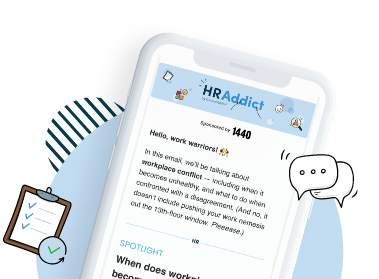The issue of sexual harassment has been a silent whisper in corridors for years now, but with recent high-profile cases coming to light, the floodgates have opened and employees everywhere are opening up about their personal encounters in the workplace and how it has harmed them.
Since this serious topic is more important than ever before, it’s vital that, as a manager, you know what sexual harassment truly is and what actions you can take to prevent it and ensure your organization is never put under the spotlight for such a significant issue.
Here is all you need to know about sexual harassment in the workplace!
What is sexual harassment?
It’s important to first know what legally constitutes sexual harassment so you can identify if an employee has acted in such a way.
It can be defined as any unwelcome sexual advance, or any sexual conduct on the job that creates a hostile, intimidating and/or offensive workplace. This doesn’t necessarily mean that someone has to make a pass at another person for it to be considered harassment; it could simply mean sexually charged jokes or comments.
Examples of sexual harassment in the workplace
Here are some examples of what could be considered sexual harassment in the workplace:
- An employee making derogatory comments about another person’s physical appearance
- Employees sending or telling sexually explicit jokes to colleagues
- One employee sending another employee an email that uses suggestive or explicit language
- A boss or colleague referring to another coworker in a sexist and demeaning way
- A manager making advances at an employee in order for them to get ahead in the workplace
- A worker groping a coworker
- An employee asking another out on a date over and over again, and/or unwanted flirting
- Displaying sexually suggestive objects or pictures in the workplace
Workplace sexual harassment statistics
Here are some interesting, yet deeply alarming, stats regarding sexual harassment in the workplace:
37%
of women have experienced one or more forms of sexual harassment in their career — 22% of men also report having been sexually harassed.
Source: Women in the Workplace 2024
99.8%
of people who have experienced sexual harassment at work never make a formal report.
$300 million
has been recovered for workers with sexual harassment claims through resolved charged receipts and in litigation.
53%
of women who have experienced sexual harassment in the workplace believe that reporting it won’t be effective.
Source: Women in the Workplace 2024
How to prevent sexual harassment
Preventing sexual harassment is crucial for employee safety and happiness. Here’s how to go about it:
1. Create a strong policy
If you haven’t already outlined your sexual harassment policy in your employee handbook, it’s time to consult a legal advisor and implement this immediately. You could also include it on your company service or on the general bulletin to ensure employees can revisit it and have easy access to it whenever they want. It’s important to keep reviewing and revising it to see if any amendments are necessary.
Your policy should typically include a statement about how the organization is committed to providing a zero-tolerance policy on discrimination and a harassment-free workplace, and that all employees are expected to follow this policy. You should also include that any claims brought forward will be kept confidential until further noted by the employee.
2. Never encourage inappropriate jokes
We’re all human and occasionally find some inappropriate situations quite comical, but in a workplace setting, you should remain professional at all times. Never laugh or encourage anything that could be considered inappropriate, even if it is a minor comment.
If you’re in a situation where an employee makes an inappropriate joke, be sure to let them know that it’s not acceptable so others don’t think they can behave in this manner too.
3. Provide training and workshops
It is essential that all supervisors and managers complete training on how to handle and prevent sexual harassment; it’s important for managers to pass this information down to their staff through various training sessions, too.
It’s also a good idea to mention that bystanders can also come forward and report harassment or sexism on behalf of another employee. Many victims may feel too scared to or vulnerable to talk about it themselves, and bystanders don’t realize that they have the right to step in — so bringing this to light will open everyone’s eyes and make all staff feel supported.
4. Respond to complaints right away
It’s vital that you take immediate action to every single complaint and try to find a solution as soon as possible. There are thousands of cases where claims are pushed to the side and not taken care of, leaving the employee no other choice than to leave the organization or take external legal action.
It’s ideal to have set measures and steps in place for when you receive a complaint. Employees should first be able to express their concerns confidentially before having to involve their alleged harasser. They should then be given a number of options and should decide for themselves which method they’d like to follow through with.
5. Keep an eye on the workplace
You should regularly check up on your employees to see that the workplace is harassment-free. You can also encourage supervisors to walk around in case they overhear any cases that could be considered harassment. A constant presence of authority may discourage any harassment from occurring in the first place.
6. Encourage staff to open up
Ensure your supervisors have a clear line of communication with staff members so they feel comfortable talking to them and feel safe opening up about personal issues.
Managerial figures should regularly check in with their team members and should arrange a private chat if they feel like something is wrong. They are the ones who know their personalities best and can detect when something isn’t quite right.
You could also think of other measures, like keeping an anonymous dropbox where staff drop comments into a box about the workplace and the company culture in general. It can help improve the organization as a whole and address any issues that people are scared to talk about in person.
How to set up an anti-harassment program
Here are a couple of pointers for setting up an anti-harassment program:
Having a number of authority figures that employees can talk to
Rather than having just a single supervisor or HR worker dealing with sexual harassment cases, you should arrange for a number of different authority figures to be open to talk to any employee from any department about this type of issues.
A single employee may find another supervisor more approachable than their own and will feel more comfortable talking to them; therefore, the more open lines of communication you have, the better.
Creating a support group
If your organization has the budget, you could consider setting up a support group for employees that are suffering from harassment or any other mental health issues. You can set up a hotline, chat system, website or set a specific HR representative in your organization to deal with such issues.
How to implement legal protection framework
There are two main legal frameworks governing sexual harassment prevention in the workplace, including:
- Title VII of the Civil Rights Act of 1964, which protects employees and job applicants from discrimination based on age, gender, religion and other protected characteristics
- State-specific anti-harassment laws, which complement or expand upon the federal protections of the Civil Rights Act, which can include the legally required provision of anti-harassment training
As an employer, it is your duty to ensure your company follows these frameworks, and this entails the following:
- Developing and implementing relevant policies related to sexual harassment
- Providing regular, comprehensive training programs and raising awareness
- Ensuring confidentiality and non-retaliation for employees who report sexual harassment cases
- Conducting prompt, thorough and impartial investigations, and treating all parties fairly
- Taking appropriate disciplinary action against perpetrators
- Providing legal recourse for victims
How to create a safe culture
Don’t wait for a formal sexual harassment complaint to come in to act. Instead, take a proactive approach into creating a safe workplace culture that prevents sexual and other forms of harassment from the get-go and promotes safety.
Here’s how to achieve this:
- Establish comprehensive anti-harassment policies that clearly outline and define what behaviors are considered unacceptable and what the consequences are.
- Promote open communication by establishing relevant channels that victims and bystanders can use to safely report sexual harassment incidents.
- Lead by example and, especially important, hold business leaders accountable for fostering a safe, inclusive work environment.
- Incorporate regular DEI training into your business operations to celebrate differences and discourage discrimination and other inappropriate behaviors.
- Conduct regular reviews of your policies, and update them to relevant laws and regulations as needed.
Frequently asked questions
Here are some questions related to preventing sexual harassment in the workplace:
Q: Who can be a victim of sexual harassment?
Sexual harassment knows no gender. While victims are usually women, men can also experience harassment in the workplace. Meanwhile, the victim doesn’t necessarily have to be the opposite sex of that of the harasser.
Q: Who can be a sexual harasser?
The perpetrator can be either a man or a woman, and they can be the victim’s coworker, supervisor or a stakeholder. They may even be a client or other non-employee of the company.
Q: Can an employee file a complaint for sexual harassment if they consented?
Yes, especially if the victims feels that the perpetrator pressured them, whether perceived or real, into engaging in sexual activity, such as blackmailing them into a promotion.
Final thoughts
There is no guaranteed way that you can avoid sexual harassment in the workplace entirely. But by using these steps and strategies, you should be able to keep a close eye on it and tackle each case before it gets out of hand. It’s about setting a policy and emphasizing what’s right and what’s wrong.
Have you enforced a sexual harassment policy? Let us know how your organization tackles this problem in the comments section below.
This article is a partial update of an earlier version originally published in 2018.

